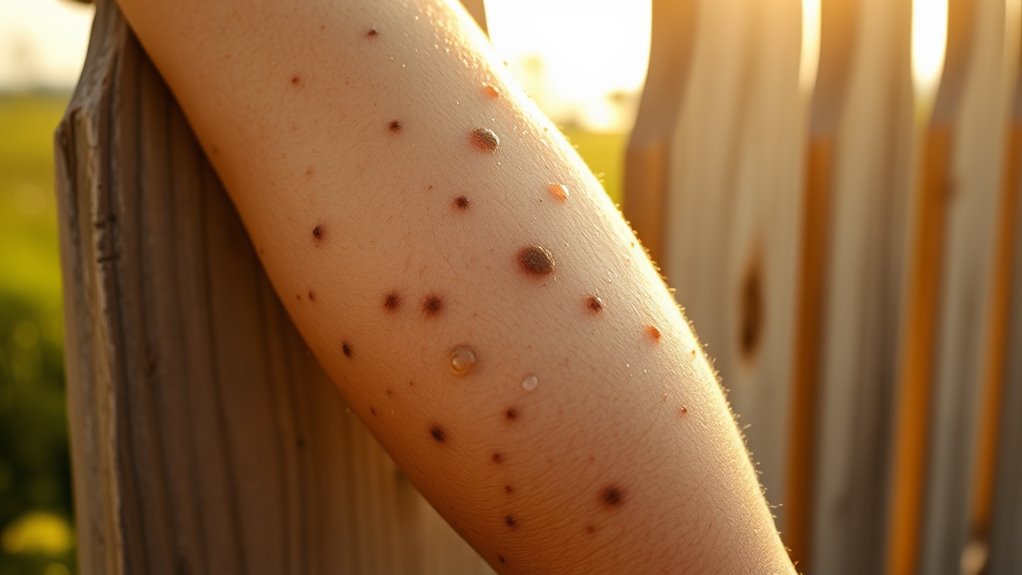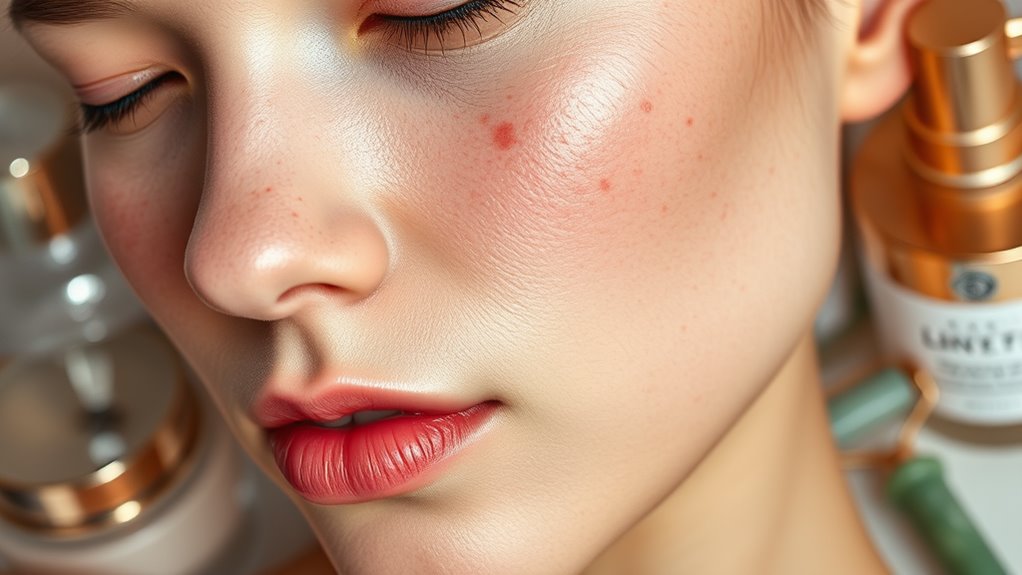This Common Mistake Can Lead to More Dark Spots
Neglecting daily sunscreen application is a common mistake that significantly increases your risk of developing dark spots. UV rays can penetrate clouds and cause skin damage any time you’re outdoors. Without proper protection, sun exposure triggers melanin production, leading to hyperpigmentation. Choosing the right broad-spectrum sunscreen and applying it regularly is essential. Understanding how to effectively protect your skin can make a difference in preventing dark spots and maintaining an even complexion. Discover more about effective sun protection strategies.
Key Takeaways
- Neglecting daily sunscreen application allows UV rays to trigger increased melanin production, leading to more dark spots.
- Over-exfoliating can irritate the skin, causing inflammation and worsening hyperpigmentation.
- Using harsh skincare products may damage the skin barrier, exacerbating dark spots and sensitivity.
- Not hydrating adequately can impair skin renewal and promote persistent pigmentation issues.
- Failing to identify and avoid personal triggers, like hormonal changes or medications, can worsen existing dark spots.
Understanding Dark Spots and Their Causes
While you may not realize it, dark spots on your skin are a common concern that can stem from various factors. These spots, often referred to as hyperpigmentation, can arise from sun exposure, hormonal changes, or skin injuries.
One common dark spot mistake is neglecting to address underlying skin conditions, which can worsen pigmentation over time. Additionally, using harsh products or failing to moisturize can exacerbate dark spots, making them more prominent. Understanding the primary causes is crucial for effective prevention and treatment. By identifying triggers and modifying your skincare routine accordingly, you can take control of your skin’s appearance and minimize the risk of developing more dark spots.
Mastery of this knowledge empowers you to achieve healthier, clearer skin.
The Importance of Sun Protection
Protecting your skin from the sun is crucial if you want to prevent dark spots.
Daily application of sunscreen helps shield against harmful UV rays, which can accelerate skin damage. Additionally, never skipping sunscreen is essential to ensure your skin’s best defense against premature aging and skin cancer.
Daily Sunscreen Application
Daily sunscreen application is essential for maintaining healthy skin and preventing dark spots caused by UV exposure. Regardless of the weather, you should apply a broad-spectrum sunscreen with at least SPF 30 every day.
This protects your skin from both UVA and UVB rays, which can lead to premature aging and hyperpigmentation. Don’t forget to reapply every two hours, especially if you’re sweating or swimming.
Use enough product—approximately a nickel-sized amount for your face alone. Ensure you cover all exposed areas, including the ears and neck.
Integrating this simple step into your daily routine can significantly reduce the risk of dark spots and enhance your skin’s overall appearance, contributing to long-term skin health.
Prioritize this habit for optimal results.
UV Protection Awareness
Understanding the significance of sun protection is crucial for anyone aiming to maintain healthy skin and prevent dark spots. UV radiation, even on cloudy days, can trigger hyperpigmentation, leading to unwanted dark spots.
You need to incorporate a broad-spectrum sunscreen with an SPF of at least 30 into your daily routine, ensuring full coverage on all exposed skin. Remember to reapply every two hours, especially after swimming or sweating.
Wearing protective clothing, sunglasses, and seeking shade during peak sun hours can further enhance your defense against harmful rays. Educating yourself on the types of UV rays—UVA and UVB—empowers you to make informed choices.
Prioritizing UV protection isn’t just about aesthetics; it’s a fundamental step in safeguarding your skin’s health.
Common Misconceptions About Sunscreen
Many people believe that sunscreen is only necessary on sunny days, but harmful UV rays can penetrate clouds. Additionally, relying solely on SPF numbers can lead to misunderstandings about effective protection. You also need to consider when and how to apply sunscreen for optimal results. To effectively prevent dark spots, it’s crucial to consistently use sunscreen every day of the year regardless of weather conditions.
Sunscreen Only on Sunny Days
Some people mistakenly believe that sunscreen is only necessary on sunny days, but this misconception can lead to serious skin damage.
UV rays penetrate clouds and can still harm your skin, even when it’s overcast. Regular application of broad-spectrum sunscreen is crucial, regardless of the weather.
If you skip sunscreen on cloudy days, you risk accumulating UV damage over time, which contributes to dark spots and premature aging.
Moreover, reflective surfaces, like water or snow, can intensify UV exposure.
To protect your skin effectively, apply sunscreen daily, ensuring you cover all exposed areas.
Remember, consistent use is key to maintaining your skin’s health and preventing unwanted pigmentation.
Don’t underestimate the power of UV rays—your skin deserves protection every day.
SPF Numbers Mean Everything
Relying solely on SPF numbers can lead to misunderstandings about how well sunscreen protects your skin.
While a higher SPF indicates greater protection against UVB rays, it doesn’t account for several essential factors:
-
Broad-spectrum protection: Ensure your sunscreen guards against both UVA and UVB rays.
-
Application amount: Most people apply only a fraction of the recommended amount, reducing effectiveness.
-
Water resistance: Not all sunscreens hold up in water or sweat; choose wisely for your activities.
-
Reapplication frequency: SPF protection diminishes over time, necessitating regular reapplication, especially after swimming or sweating.
-
Skin type: Individual factors, such as skin tone and sensitivity, affect how sunscreen performs.
Understanding these elements will enhance your sun protection strategy and reduce the risk of dark spots.
Application Timing Doesn’t Matter
While you might think that applying sunscreen just before heading outdoors is sufficient, the timing of application plays a crucial role in its effectiveness.
To ensure optimal protection, you should apply sunscreen at least 15 to 30 minutes prior to sun exposure. This allows the product to bind effectively to your skin and create a protective barrier.
Additionally, don’t forget to reapply every two hours, or more frequently if you’re sweating or swimming. Many people mistakenly believe that one application lasts all day, but UV rays can quickly diminish the effectiveness of the sunscreen.
How UV Rays Contribute to Dark Spots
Although many people enjoy soaking up the sun, it’s crucial to understand how UV rays contribute to the formation of dark spots on your skin.
When your skin is exposed to ultraviolet radiation, it triggers melanin production as a defense mechanism. This process can lead to an uneven distribution of pigment, resulting in dark spots.
Consider the following factors:
- Sun exposure duration: Longer exposure increases the risk.
- Skin type: Fair skin is more susceptible to damage.
- Geographical location: Closer to the equator means stronger UV rays.
- Time of day: UV rays are strongest between 10 AM and 4 PM.
- Cumulative exposure: Repeated, unprotected sun exposure compounds the effect.
Additionally, preventive measures such as wearing sunscreen daily can significantly reduce the risk of developing dark spots.
Protect your skin proactively to prevent these unwanted marks.
Choosing the Right Sunscreen for Your Skin
Selecting the right sunscreen for your skin is essential for effective protection against dark spots and other sun-related damage.
Start by identifying your skin type—oily, dry, or combination—as this influences your choice. Look for broad-spectrum protection, which shields against both UVA and UVB rays. Opt for a sunscreen with an SPF of at least 30 for adequate defense.
If you have sensitive skin, consider mineral-based formulas containing zinc oxide or titanium dioxide, as they’re less likely to cause irritation. For oily skin, choose a lightweight, non-comedogenic sunscreen to prevent clogged pores.
Always check ingredient labels for potential allergens or irritants. By making informed choices, you can safeguard your skin and reduce the risk of dark spots effectively. Additionally, proper sunscreen application techniques can significantly enhance its effectiveness in preventing dark spots.
Applying Sunscreen: Tips for Maximum Effectiveness
Once you’ve chosen the right sunscreen for your skin type, applying it correctly is key to maximizing its protective benefits.
Here are some essential tips to ensure you’re getting the most out of your sunscreen application:
-
Apply generously: Use about a shot glass full for your entire body.
-
Don’t forget your face: Apply to all exposed areas, including ears, neck, and scalp.
-
Timing matters: Apply sunscreen at least 15 minutes before sun exposure to allow it to absorb.
-
Reapply often: Reapply every two hours, or immediately after swimming or sweating.
-
Layer your products: Use sunscreen as the last step in your skincare routine for optimal effectiveness.
Following these guidelines will help you achieve maximum protection against dark spots and sun damage.
Other Factors That Can Worsen Dark Spots
While sunscreen is vital for preventing dark spots, several other factors can exacerbate their appearance. Hormonal fluctuations, particularly during pregnancy or menopause, can lead to increased melanin production, resulting in more pronounced spots.
Additionally, certain medications, such as oral contraceptives or antibiotics, may heighten sensitivity to sunlight, worsening pigmentation.
Lifestyle choices, including smoking and excessive alcohol consumption, can also contribute to skin damage and uneven tone.
Moreover, neglecting proper hydration can impair your skin’s ability to renew itself, making dark spots more visible.
Lastly, inadequate exfoliation hinders the shedding of dead skin cells, allowing pigmentation to persist.
Being aware of these factors enables you to take proactive steps in your skincare routine.
Treatments for Existing Dark Spots
Effective treatments for existing dark spots can significantly improve your skin’s appearance and restore its even tone.
By incorporating targeted solutions into your skincare routine, you can achieve noticeable results. Consider these options:
-
Vitamin C Serums: Brighten and clarify skin tone while reducing pigmentation.
-
Retinoids: Promote cell turnover and encourage new skin growth to fade dark spots.
-
Chemical Peels: Exfoliate the skin’s surface, revealing fresher, less pigmented layers beneath.
-
Laser Treatments: Target specific spots with precision, effectively diminishing their appearance.
-
Hydroquinone: A topical agent that lightens dark spots by inhibiting melanin production.
Explore these treatments to reclaim a vibrant, uniform complexion and boost your confidence.
Each option offers unique benefits tailored to your skin’s needs.
Preventative Measures for Healthy Skin
To maintain a radiant complexion and prevent dark spots from forming in the first place, adopting a proactive skincare regimen is vital.
Start by incorporating a broad-spectrum sunscreen with at least SPF 30 into your daily routine. This shields your skin from harmful UV rays that contribute to pigmentation.
Next, include antioxidants like vitamin C in your regimen; they help combat free radicals and brighten your skin.
Regular exfoliation, using gentle acids or enzymes, promotes cell turnover, reducing the risk of dark spots.
Additionally, stay hydrated and maintain a balanced diet rich in vitamins and minerals.
Finally, avoid smoking and limit alcohol consumption, as these habits can exacerbate skin issues.




